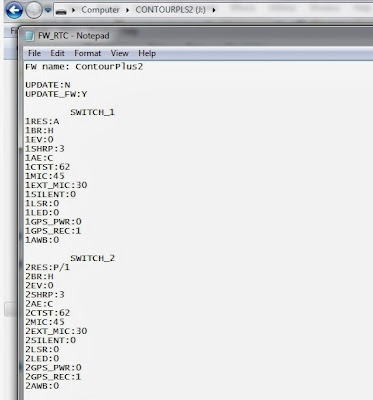Backup
Before you start, make a backup of the file:
- Plug your camera into your computer, and browse to the contour drive that appears
- In the root folder, you should see a file called "FW_RTC.txt" which is the configuration file.
- Make a copy of this file on your computer
Ensure file is not "Read only"
Now, going back to the contour drive on your computer, right click on the file and make sure it's not "read only" - uncheck this box if its checked before you start.
Explore the file
Open up "FW_RTC.txt" on your device. This first part of the file, tells you what you have configured the programmable switch buttons 1 & 2 on, when you open up the back of the camera :
And this part of the file, defines what parameters you can enter, for each of the options in the settings above:
For example, if I wanted to change program otpion 1 from "A" - 1920x1080 30fps (NTSC)/25fps (PAL) to "G" 848x480 120fps (NTSC)/100fps (PAL) I simply change it to:
You'll notice I also change the 2 update settings to "Y" - this ensures the device firmware gets updated next time you power on the camera. If you leave it on "N" nothing will change.
To save your changes, just save the notepad file. Make sure you eject the device properly from windows before you unplug it. And you do this at your own risk! Make sure you test it before you need it....
Option for travelling
A good option if you are travelling,could be to make a couple of copies of the configuration file with the various settings you prefer, then just copy the one you want to have active onto the device whenever you need it. For example, have a couple of different microSD cards with you, and use one for HD video in low light, and a different microSD with different settings for other shooting conditions.




No comments:
Post a Comment